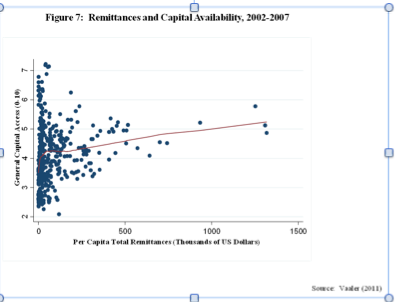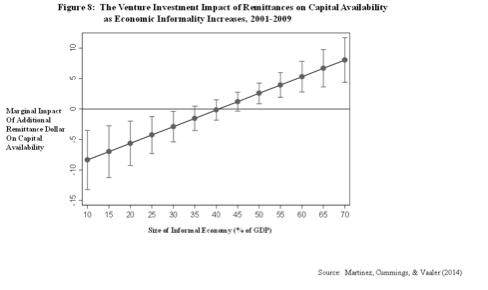Cabbies and Capital: Migrants are Re-shaping the Developing World

Let’s not bury the lead: Today, the richest, most daring and influential group of venture capitalists in the world are migrants from developing countries.
That’s right, migrants -- the cabbie from Somalia who drove you home from the airport last week; the agricultural worker from Mexico who picked the lettuce for your salad this evening; the handyman from Guatemala who fixed your bedroom closet light last month; the Filipina who has cleaned your home and watched your school-age children for the last five years. As a group, they are responsible for more money and ideas going into more new businesses driving more entrepreneur-led economic growth in more developing countries than any other business, government or other foreign investor group.
Yet entrepreneurship researchers in business schools hardly know it, let alone study it. We should.
I can guess your initial reaction to this: skepticism bordering on the derisive. I understand. At first glance, today’s migrants from developing countries may not strike any of us in business schools as entrepreneurs actively engaged in new venture funding, founding and growth. Like previous waves, today’s migrants often come to the US or other Western countries with very little money or other apparent support. They come with little and think they can fill jobs, skilled or unskilled, that native-born citizens cannot or will not fill. They come with little because they just fled catastrophes of Nature’s making like earthquakes in Haiti; or catastrophes of Man’s making, like civil war in Somalia.
Whatever their motivation, migrants arrive, live among us and work in jobs “below” us economically and socially. I mean no offense here. It is so often the migrant’s lot to sacrifice through re-settlement so that the next generation might have more opportunity. That first generation become the less fortunate, working and earning to give their children a better future and to give their sometimes even less-fortunate relatives back home a little financial help from abroad.
Migrant Money Flows Home...
A lot of financial help is going back home from a lot of migrants in host countries. The world in 2010 had more than 200 million migrants: people not living in their countries of birth or childhood. That’s up from about 70 million in 2000. Today, the invisible country of “Diasporia” would be the fifth-largest in the world. The money they remit -- by remittance, I mean individual-to-individual or household-to-household transfers of money -- is staggering by any measure. Remittances to developing countries were about $100 billion (yes, billion) in 2000. In 2014, remittances exceeded $400 billion (yes, 400). The rise in remittance totals was steady in the 2000s, with only a short pause for the 2008-2009 world recession. Don’t take my word for this. Ask senior executives in large money transfer organizations (MTOs) like US-based Western Union and Moneygram or Europe-based Ria Financial. Migrant remittances are their lifeblood, and blood pressure has been strong.
It’s one thing to note large and increasing numbers of migrants from the developing world and their remittances back to it. It’s another thing to document whether some remittances are really going to developing countries for venture investment purposes. It might be that poor migrants are simply sending money home to even poorer relatives for subsistence purposes: food and clothing for the family; tuition fees for a nephew attending primary school that cannot hope to find adequate funding from local property taxes; bills from doctors and pharmacists for health checks and medicines; repairs to housing that was poorly constructed in tough neighborhoods; repayment of loans to the migrant from that same group of friends and family years ago. And that could be accurate. Subsistence uses for remittances could still dominate.
But what if even a small percentage of remittances goes to help start or bolster micro-enterprises run by migrant relatives or maybe neighbors from the same community back home? This could also be a “subsistence” use of remittance dollars. Often, would-be entrepreneurs in developing countries have fewer employment opportunities than their counterparts in wealthier, industrialized countries. Especially in rural regions, an unemployed villager may have no choice but to start his or her own business and income source – necessity entrepreneurship at its most emphatic.
Remittances from a friend or family member abroad may be little more than $100-250 a month. But that money is steady. And it might be more than enough to start a micro-enterprise: enough to start a fruit stand in the village where the migrant was raised; enough to rent or buy a truck that delivers fruit to the next village during the day and then serves as a taxi in the home village during evenings. That’s remittance-based venture investing even if it is on a small scale, and on an unregulated, informal basis.
...And Improves Capital Access
Do those remittance dollars to developing countries really move the dial on venture funding availability, on new business founding rates, on the broader economic growth and openness to the world economy? Ask Dilip Ratha at the World Bank. Since at least 2003, he has been telling economic development experts and anyone else who cares to listen that remittances are an “important and stable source of external development finance” (Ratha, 2003). Ask David Yang, one of those development economists who has been listening and documenting the use of remittances for business purposes in many rural areas of developing countries (Yang, 2011). They’ll tell you yes, and point to emerging evidence in policy reports and in development economic journals.
Then ask me. I’ll show you this picture. It comes from a paper I published in the Journal of International Business Studies in 2011 (Vaaler, 2011). The data on the horizontal x-axis of this figure are remittances (divided by the number of people in the developing countries where the remittances go) from the World Bank’s World Development Indicators. The data on the vertical y-axis are estimates of capital availability in more than 50 developing countries from 2002-2007. That information is from the Michael Milken Institute in Los Angeles.

The locally-weighted scatter-plot smoothed trend line moves steeply upward from $0-100 in remittances per capita, then trends upward more gently from $100 to more than $1,000 in remittances per capita – the outlier observations at about $1300 in remittances per capita are from Lebanon. In any case, the trend is unmistakable. As remittances to developing countries increase, capital access there also increases. That same positive trend persists if simply re-plotted as a natural log to control for outliers, or if re-estimated after controlling for all sorts of other factors that might explain this trend. Remittances matter significantly, substantially and positively for general capital access in developing countries.
And they matter even more for venture capital access in the least-developed countries of the world, where legal and regulatory institutions to protect foreign investors are weak or non-existent. Let’s start again with a picture, this time from a more recent article I co-wrote with Candy Martinez and Michael Cummings. Our article will appear in the July 2015 issue of the Journal of Business Venturing (Martinez, Cummings, & Vaaler, 2015):

Here, the data come from more than 40 developing countries observed from 2001-2009. The horizontal x-axis measures the size of a developing country’s informal economy as a percentage of the country’s gross domestic product (GDP). The informal economy is the value of all transactions that are not observed and regulated by the local government. That percentage can be substantial in some countries –more than 70% in Somalia or Liberia. These data come from an economist, Friedrich Schneider (Schneider, 2002; Schneider, Buehn, & Montenegro, 2010). The vertical y-axis is the marginal effect of an additional remittance dollar on capital access in the developing country. Candy, Michael and I used a measure of venture capital availability for each country and year published by the World Economic Forum as part of its annual country competitiveness survey. We regressed that annual venture capital availability measure on several factors, including the level of informality in and remittances to each developing country. We then used coefficient estimates from that regression to simulate the effect of remittances on venture capital availability at different levels of informality measured as a percentage of country GDP.
The dots are effect estimates. The brackets are confidence intervals set at the 5% level (p < 0.05). If those brackets do not cross the “0” line in the middle of the figure, then we can be 95% sure that the marginal effects are negative (as they are when informal economy is less than 30% of GDP) and positive (as they are when the informal economy is more than 50% of GDP).
Again, the trend is clear. Once the informal economy is more than 50% of the total economy in a developing country, remittances contribute significantly, substantially and positively to capital access critical to funding new businesses.
The Migrant's Transnational Advantage
So it's clear that remittances increase not only venture capital availability, but also new business starts and the broader economic openness of these same developing countries, and more so the less developed they are. Check out my recent papers documenting these points (Vaaler, 2011, 2013; Martinez et al., 2015). My own rough estimates are that from 2-10% of remittances go to funding new businesses in developing countries, with higher percentages for remittances to less developed countries. Even 2% of $400 billion is a lot of money for funding, founding and growing new businesses in the developing world. In any case, it far exceeds more conventional venture investment flows from, say, international venture capital firms.
Why are migrants taking such risks? Familial or community altruism is one explanation. They care about those back home. Indeed, they might also owe them money lent years ago to make the voyage. But I think more conventional reasons explain why migrants are investing where other conventional foreign venture investors like banks and venture capital firms are unwilling.
One reason is that migrants have an advantage when investing in a world without conventional investor protections: that is, in a world with institutional “voids.” Migrants have alternative means of assuring the intended business use of their investment. They have extended family and community relationships to replace more conventional protections related to contracting and property rights. Migrants can take advantage of what I call “transnational clan capitalism.” Their advantage works as long as the investments are small, as long as they are targeted on the migrant’s home-country locale, and as long as conventional foreign investor protections like enforceable contract and property rights are lacking. Once any of these conditions is lost, the migrant advantage is also lost and remittances will revert back to other non-business uses. But for so many developing countries, those conditions are all in place and likely to stay in place in the near term.
Worth More Study and More Doing
Needless to say, this phenomenon is ripe for more study in business schools. Eventually, business academic journals will figure out that this research merits more attention. Here’s your opportunity to jump in. If you are mulling over topics, let me suggest one. Did you know that total remittances to a country are really the total of three types of remittances that may very well have different venture investment properties?
Workers remittances account for, on average, about 70% of the total. They are remittances that come from migrants who have been resident abroad for more than a year. Some researchers, including me (e.g., Vaaler, 2013) use only this component to distinguish remittances from a second group who migrate but don’t stay in one host country for at least a year – think of seasonal workers in agriculture or the traveling merchant. This second remittance component is called compensation of employees and accounts for about 25% of the total.
Lastly, household transfers are a small but occasionally important remittance component. When migrants return from their travels, they often bring back assets like a car or some other durable good. These have value, too, and can matter substantially to total remittances when migrants repatriate in large numbers, as Mexican migrants did following the US's Great Recession in the late 2000s. Think of the questions we can ask about whether and how these remittance components may affect new venture funding availability, new venture founding rates, and new venture growth and survival rates differently.
Along with research opportunities, think about business opportunities related to these transnational phenomena. There are many ways to participate. One approach I think particularly interesting is to offer migrants value-added products and services at the point of remittance: a coupon good for educational fees for a nephew or a credit good for medical expenses for an aunt back in the migrant’s home country. That coupon or credit could be bought in bulk by an enterprising middle-woman in the migrant’s home country (e.g., Mexico) and then offered to the migrant at a money transfer organization in the host country (e.g., US). When a migrant comes to an MTO in the US to remit $100 to Mexico to pay for a nephew’s school fees there, she might be able to buy, say, a $105 educational fee coupon value good for redemption at some list of participating schools in Sonora State. Our middle-woman went to those schools six months earlier and prepaid enough in fees to get a discount from $100 to only $95. So our remitting migrant gets $105 in tuition value, not $100. The schools get $95 in tuition fees paid in advance for what is likely to be a throng of students. Our middle-woman pockets the difference between her discounted fee per student of $95 and the migrant’s remittance of $100. That would be $5 per transaction, with thousands of transactions at the beginning of each school semester. Not bad.
Enjoy the Ride
Maybe now you see migrants differently, as potential venture investors linking host and home countries. But looking and thinking differently are not enough. Time to do more research on their transnational entrepreneurial behaviors, so important to private sector-led economic development and poverty reduction in the developing world. Maybe even time to do some transnational business with them, perhaps through a value-added service or product offering. Want to know how to start? I’m happy to chat with you, but I’m not the best starting point. That would be your cabbie. Enjoy the ride.
References
Martinez, C., Cummings, M., & Vaaler, P. 2015. Economic Informality and the Venture Funding Impact of Migrant Remittances to Developing Countries, Journal of Business Venturing, 30(4): 526-545.
Ratha, D. 2003. Workers' remittances: An important and stable source of external development finance. Global Development Finance: Striving for Stability in Development Finance, Chapter 7. World Bank, Washington, DC, pp. 157–175.
Schneider, F. & Enste, D. 2002. The shadow economy. Cambridge, UK, Cambridge University Press.
Schneider, F., Buehn, A., & Montenegro, C. 2010. New estimates for the shadow economies all over the world. International Economic Journal, 24: 443-461.
Vaaler, P. 2011. Immigrant remittances and the venture investment environment of developing countries. Journal of International Business Studies, 42: 1121-1149.
Vaaler, P. 2013. Diaspora concentration and the venture investment impact of remittances. Journal of International Management, 19: 26-46.
Yang, D., 2011. Migrant remittances. Journal of Economic Perspectives, 25: 1–24.



